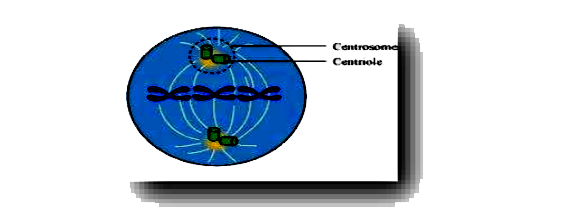Describe the structure of the following with the help of labelled diagrams. (i) Nucleus (ii) Centrosome
Video Solution
Text Solution
(i) Nucleus
Nucleus controls all the cellular activities of the cell. It is spherical in shape. It is composed of the following structures:
Nuclear membrane: It is a double membrane separating the contents of the nucleus from the cytoplasm. The narrow space between the two membranes is called the perinuclear space. Nuclear membrane has tiny holes called nuclear pores. These holes allow specific substances to be transferred into a cell and out from it.
Nucleoplasm/Nuclear matrix: It is a homogenous granular fluid present inside the nucleus. It contains the nucleolus and chromatin. Nucleolus is a spherical structure that is not bound by any membrane. It is rich in protein and RNA molecules, and is the site for ribosome formation. Chromatin is an entangled mass of thread-like structures. It contains DNA and some basic proteins called histones.
 (ii) Centrosome
(ii) Centrosome
Centrosome consists of two cylindrical structures called centrioles. Centrioles lie perpendicular to each other. Each has a cartwheel-like organisation. A centriole is made up of microtubule triplets that are evenly spaced in a ring. The adjacent triplets are linked together. There is a proteinaceous hub in the central part of a centriole. The hub is connected to the triplets via radial spokes. These centrioles help in organising the spindle fibres and astral rays during cell division. They form the basal body of cilia and flagella.

|
Topper's Solved these Questions
Similar Questions
Describe the structure of anatropus ovule with the help of labelled diagram.
View SolutionDescribe the structure of sex chromosomes with the help of labelled diagram.
View SolutionDescribe the structure of a sacromere with the help of a labelled diagram.
View SolutionDescribe the structure of a human kidney with the help of a labelled diagram.
View SolutionExplain the structure of neuron with the help of a labelled diagram.
View SolutionExplain the structure of a nephron with the help of a labelled diagram.
View SolutionDescribe the reflex action with the help of labelled diagram.
View SolutionDescribe the structure of mature Graafian follicle with labelled diagram.
View SolutionBriefly describe the structure of ear with the help of a suitable diagram.
View SolutionDescribe the septic tank based toilet with the help of a labelled diagram .
View Solution
